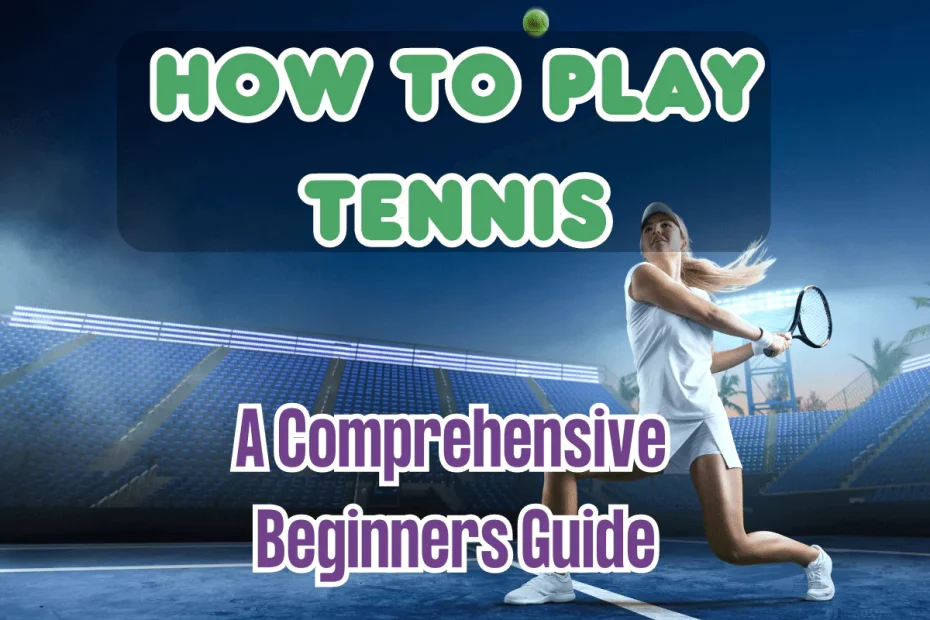Are you bored and looking for a new hobby to dive into? Learning how to play tennis might just be the perfect sport for you!
Tennis is a game of skill, strategy, and endurance that can be played at any age and at any skill level. Whether you’re looking to compete professionally or just want a fun way to stay active, tennis offers a multitude of benefits.
In this comprehensive beginner’s guide, we’ll cover everything you need to know to get started with tennis.
From understanding the basic rules to mastering the different strokes and techniques, we’ll provide you with all the information you need to step onto the tennis court with confidence.
So, grab your racquet, and let’s get started on learning how to play tennis!

Article Content:
What is Tennis?
Tennis is a racquet sport that can be played individually against a single opponent (singles) or between two teams of two players each (doubles). The game is played on a rectangular court, either grass, clay, or hard surface, divided by a net in the middle.
The objective of the game is simple: hit the ball in such a way that your opponent is unable to make a valid return. The ball must be hit into the opponent’s court and can only bounce once before the opponent must return it.
The player who is unable to return the ball will not gain a point, while the other player will.
Learning how to play tennis requires both physical agility and mental focus. It involves running, jumping, and precision hitting, thereby providing a good workout for both your body and your mind.
Whether you’re playing a friendly match at a local club or competing in a professional tournament, tennis offers a challenge and excitement at every level.
Brief History of Tennis
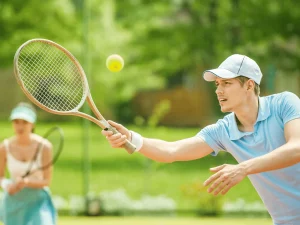
The origins of tennis can be traced back to the 12th century in France, where it was played by monks in monastery courtyards. Back then, it was a handball game called “jeu de paume” (game of the palm), and players hit the ball with their hands instead of a racquet.
The game evolved over the centuries, with racquets being introduced in the 16th century and the rules resembling the modern game of tennis being established in the 18th century. The term “tennis” comes from the Old French word “tenez,” which means “take heed” – a warning from the server to the receiver.
The first championships were held at Wimbledon, England, in 1877, marking the beginning of professional tennis. The game has since grown in popularity and is now played at various levels, from local clubs and schools to international tournaments like the Grand Slam events.
In the first section of our beginner’s guide, we’ll explore the benefits of playing tennis, both physical and mental, and why it’s a great sport to take up if you’re looking to bust boredom.
Benefits of Playing Tennis
Playing tennis has numerous benefits, making it a great hobby for those looking to bust boredom and improve their overall well-being.
Here are some of the key benefits when you start learning how to play tennis:

Physical Benefits
Starting a new hobby like tennis can have a number of benefits for your overall physical health.
Tennis can help improve things such as:
- Full Body Workout: Tennis involves the use of almost every muscle in your body. From running to swing the racquet, you’re giving both your upper and lower body a good workout.
- Improves Cardiovascular Health: Tennis is an excellent cardiovascular exercise. It helps to improve heart health by increasing your heart rate and improving your body’s oxygen consumption.
- Enhances Coordination: Tennis requires a lot of hand-eye coordination. Regularly playing tennis can help improve your balance, agility, and coordination.
- Strengthens Bones: Regular physical activity like tennis can increase bone density, which can help prevent osteoporosis.
Mental Benefits
Not only does tennis challenge you physically, but it’s surprisingly challenging mentally. This can benefit your mental health in a number of ways:
- Boosts Mood: Like any other physical activity, playing tennis releases endorphins, the body’s natural mood boosters. This can help reduce stress and anxiety and promote a sense of well-being.
- Improves Focus and Strategic Thinking: Tennis requires a lot of mental alertness and strategic thinking. It can help improve your concentration, tactical thinking, and decision-making skills.
- Promotes Social Interaction: Tennis is a social sport. Whether you’re playing doubles or joining a tennis club, it provides plenty of opportunities to meet new people and make friends.
Tennis Equipment: What You Need to Get Started
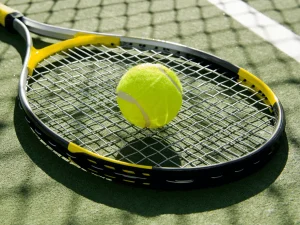
Before you step onto the tennis court, you’ll need to equip yourself with the right gear. Here’s a list of essential tennis equipment for beginners:
Tennis Racquets
The tennis racquet is your primary tool in the game. For beginners, it’s recommended to start with a racquet that has a large head size (around 100 square inches) as it offers a larger sweet spot and more power. The grip size should also be comfortable for your hand size.
Tennis Balls
Tennis balls are typically yellow and covered with a fibrous felt. They come in different types for different court surfaces and playing conditions. For beginners, it’s best to start with standard duty balls which are suitable for most court surfaces.
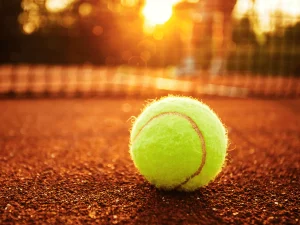
Tennis Shoes and Clothing
Wearing the right shoes and clothing can make a big difference in your game. Tennis shoes are designed to provide support and stability for the quick lateral movements in the game. As for clothing, opt for comfortable, breathable fabrics that allow for easy movement.
Tennis Court and Its Layout
Understanding the layout of a tennis court is crucial for learning the rules and strategies of the game. A standard tennis court is 78 feet long and 36 feet wide. It’s divided into two halves by a net, and the boundaries for singles and doubles play are marked by white lines.
learning how to play tennis: Basic Rules
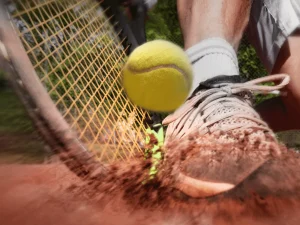
Tennis might seem complex at first, but once you understand the basic rules, it becomes much easier to follow. Here are the fundamental rules of tennis:
Scoring System in Tennis
A tennis match is composed of points, games, and sets. The player who wins the most sets wins the match. Here’s how the scoring works:
- Points: The points start at love (zero), then go to 15, 30, and 40. If both players reach 40, it’s called a deuce. From deuce, a player must win two consecutive points to win the game.
- Games: To win a game, you must win at least four points in total and be at least two points ahead of your opponent.
- Sets: A set is won by the first player to win six games with a margin of at least two games. If the set reaches 6-6, a tiebreak is played, and the first player to reach 7 points with a margin of at least two points wins the set.
Basic Rules for Singles and Doubles Matches
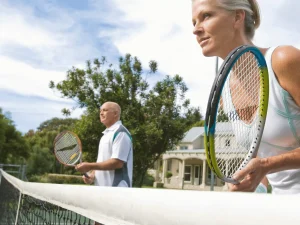
- Singles: In a singles match, the game is played between two players. The players serve alternately, each serving for an entire game. The server must stand behind the baseline and serve diagonally to the receiver’s service box.
- Doubles: In a doubles match, the game is played between two teams of two players each. The same serving rules apply, but the boundaries of the court are extended to the doubles lines.
Tennis Etiquette
Tennis is a sport that values respect and sportsmanship. Here are some basic etiquette rules:
- Always respect the lines and calls of your opponent.
- Don’t walk across another court during a point.
- Wait until a point is over before asking for a ball to be returned.
- Always shake hands at the end of a match.
How to Play Tennis: Basic Techniques and Strategies
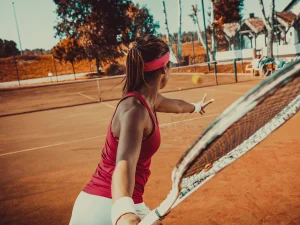
Tennis is a game of skill and strategy. Here are some basic techniques and strategies that can help you improve your game:
Tennis Grips: Eastern, Western, and Continental
The way you hold your racquet, known as your grip, can significantly impact your control and power. There are three main types of grips:
- Eastern Grip: This grip is suitable for flat shots and is generally used for forehand strokes.
- Western Grip: This grip allows for a lot of topspin and is also used for forehand strokes.
- Continental Grip: This versatile grip is used for a variety of shots including serves, volleys, and backhand strokes.
Tennis Strokes: Forehand, Backhand, Volley, and Smash
- Forehand: This is a basic stroke where you swing the racquet across your body with your dominant hand.
- Backhand: This stroke is performed from the opposite side of the body. It can be executed with either one hand or two hands on the racquet.
- Volley: A volley is a shot that is hit before the ball bounces on the ground. It’s typically used when you’re close to the net.
- Smash: A smash is a powerful overhead shot that is often used to finish off a point.
Tennis Serve Techniques
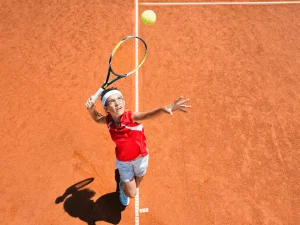
The serve is one of the most important shots in tennis. It’s the shot that starts every point and something you should focus on when learning how to play tennis.
There are different types of serves including the flat serve, slice serve, and kick serve.
Each serve has its own advantages and can be used strategically during a match.
Tennis Footwork
Good footwork is crucial in tennis. It allows you to move quickly and efficiently around the court, reach the ball in time, and position yourself properly for each shot.
Tennis Drills for Beginners
Practicing drills can help improve your skills and techniques. Some basic drills include practicing your serve, hitting the ball against a wall, and rallying with a partner.
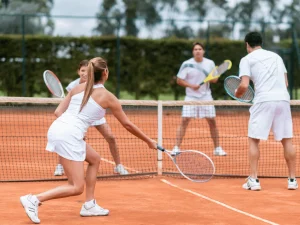
Tennis Strategy and Tactics for Singles and Doubles Matches
Understanding the strategy and tactics of the game can give you an edge over your opponent.
This includes knowing when to play aggressively or defensively, understanding your opponent’s weaknesses, and using different shots and spins to your advantage.
Sequence of a Tennis Point/Game/Match
Playing a point, game, and match in tennis involves a series of steps, from serving and returning to scoring.
Here’s a step-by-step guide:
-
Serve
The server starts the point by serving the ball from behind the baseline into the diagonally opposite service box on the other side of the net.
-
Return
The receiver hits the ball back after it has bounced once in their service box. The ball must land within the boundaries of the court.
-
Rally
Players hit the ball back and forth across the net. The rally continues until one player fails to return the ball, hits the ball into the net, or hits the ball out of bounds.
-
Scoring
The player who wins the point adds to their score. Points progress from love (zero) to 15, 30, and 40. If the score reaches 40-40, it’s called a deuce, and play continues until one player leads by two points.
-
Game
The first player to win at least four points and by two points wins the game. The server and receiver switch roles after each game.
-
Set
The first player to win six games and be at least two games ahead wins the set. If the set score reaches 6-6, a tiebreak is played to decide the winner of the set.
-
Match
The player who wins the best of three or five sets wins the match. In professional tennis, men’s matches are typically best of five sets, while women’s matches are best of three sets.

Practicing Tennis Alone: Tips & Drills
Even if you don’t have a partner, there are still plenty of ways to practice tennis alone.
It’s one of the easiest ways to start learning how to play tennis, as it removes any distractions, stress, and anxiety that may come with practicing with an experienced player or coach.
Here are some tips and drills you can try by yourself:
How to Practice Serving Alone
The serve is a crucial part of the game, and it’s something you can easily practice alone. All you need is a bucket of balls and a tennis court.
Practice different types of serves – flat, slice, and kick – and aim for different areas of the service box.
How to Practice Groundstrokes Alone
Groundstrokes, which include forehand and backhand shots, can be practiced alone by hitting the ball against a wall.
This can help improve your timing, accuracy, and consistency.
Try to hit the ball at different heights and speeds to simulate different types of shots.
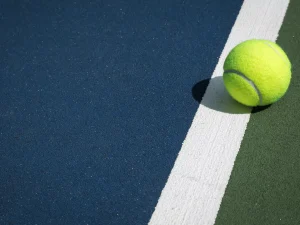
Other Useful Drills for Solo Practice
- Shadow Swinging: This involves swinging your racquet as if you were hitting a ball. It’s a great way to practice your technique and footwork.
- Ball Machine: If you have access to a ball machine, you can use it to practice different shots and movements.
- Serve and Return: Practice serving and then quickly transitioning to a baseline position to return an imaginary shot. This can help improve your serve and transition game.
Remember, the key to improve is consistent practice when learning how to play tennis.
Even if you’re practicing alone, you can make significant progress with dedication and the right approach.
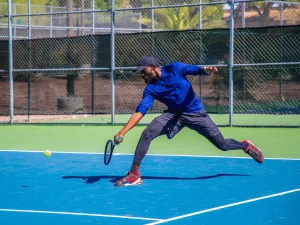
Safety Considerations When Playing Tennis
While tennis is a relatively safe sport, it’s still important to take certain precautions to avoid injuries.
Here are some safety considerations when playing tennis:
Proper Warm-Up and Cool-Down Routines
Before you start playing, it’s important to warm up your body to prepare your muscles for the physical activity.
This can include light jogging, stretching, and hitting some easy balls. After playing, cool down with some gentle stretching to help your muscles recover.
Importance of Using the Right Equipment
Using the right equipment can also help prevent injuries.
This includes wearing proper tennis shoes that provide good support and stability, and using a racquet that is the right size and weight for you.
Common Tennis Injuries and How to Avoid Them
Some common tennis injuries include tennis elbow, ankle sprains, and shoulder injuries.
To avoid these, make sure to use proper technique, don’t overuse your muscles, and take breaks when needed.
Remember, it’s always better to prevent injuries than to treat them. So always prioritize safety when playing tennis.
Cost and Budget Considerations for Playing Tennis.
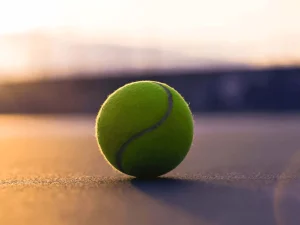
While tennis can be an expensive sport, there are ways to play it on a budget.
Here are some cost considerations and tips when learning how to play tennis:
Cost of Tennis Equipment
The cost of tennis equipment can vary greatly depending on the brand and quality. A beginner’s tennis racquet can cost anywhere from $25 to $100, while high-end racquets used by professionals can cost several hundred dollars.
Tennis balls are relatively inexpensive, with a can of three balls typically costing around $2 to $4. Tennis shoes can range from $50 to over $100.
Cost of Tennis Lessons and Court Fees
If you’re just starting out, you might want to consider taking tennis lessons.
The cost of lessons can vary depending on the location, the experience of the coach, and whether the lessons are private or group.
On average, you can expect to pay around $30 to $60 per hour for private lessons.
Court fees can also add to the cost of playing tennis. Some public courts are free to use, while others charge a small fee. Private clubs and indoor courts are generally more expensive.
Tips for Playing Tennis on a Budget
- Buy Used Equipment: Consider buying used racquets and other equipment to save money. Just make sure they’re still in good condition.
- Group Lessons: Group lessons are usually cheaper than private lessons and can be a fun way to learn the game.
- Free Courts: Look for public tennis courts in your area that are free to use.
- Practice at Home: You can practice many tennis skills at home, such as serving and swinging, which can save you money on court fees and ball machine rentals.
Remember, the most important thing is to enjoy the game.
Don’t let the cost deter you from playing and improving.
Additional Resources for Learning Tennis
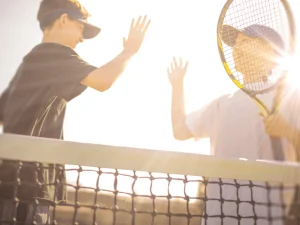
Learning how to play tennis involves more than just practice on the court. There are many resources available that can help you understand the game better and improve your skills.
Here are some recommended resources for beginners:
Recommended Books
- “Winning Ugly” by Brad Gilbert: This book provides valuable insights into the mental aspect of tennis.
- “The Inner Game of Tennis” by W. Timothy Gallwey: This classic book focuses on the psychological side of the game.
- “Tennis Skills & Drills” by Joey Rive: A comprehensive guide to tennis techniques, strategies, and drills.
Websites
There are a number of great websites you can visit that can help you learn how to play tennis.
Check out just a few here:
- Tennis Warehouse: This website offers a wide range of tennis equipment and also features helpful guides and reviews.
- Tennis.com: This site provides the latest news in the world of professional tennis and also offers instructional content for players of all levels.
YouTube Channels
- Top Tennis Training: This channel offers a wide range of tennis tutorials and drills.
- Essential Tennis: This channel provides high-quality instructional videos for all levels of players.
- Feel Tennis Instruction: This channel focuses on helping players improve their technique and feel for the game.
Local Tennis Clubs and Organizations
Joining a local tennis club or organization can be a great way to meet other players and get more practice. Many clubs offer lessons and organize social events and tournaments.
Remember, the key to improving in tennis is consistent practice and a willingness to learn.
With the right resources and dedication, you can become a skilled tennis player and enjoy this wonderful sport.
Frequently Asked Questions (FAQ) About Tennis

Here are answers to some common questions beginners might have while learning how to play tennis:
What is the best age to start playing tennis?
You can start playing tennis at any age! For children, it’s generally recommended to start around the age of 5 or 6 when they have developed enough coordination and attention span. But many adults pick up the game later in life and still enjoy it immensely.
How long does it take to learn tennis?
The time it takes to learn tennis can vary greatly depending on how often you practice and your natural athletic ability. However, with regular practice, most beginners can learn the basics and start playing games within a few months.
Do I need a tennis coach?
No. However, it’s possible to learn tennis on your own, but a coach can be very helpful, especially for beginners. A coach can provide personalized advice and corrections that you might not notice on your own.
What should I wear to play tennis?
You should wear comfortable athletic clothing that allows you to move freely. Tennis shoes are also important as they provide the necessary support and traction for the movements involved in tennis.
How can I improve my tennis serve?
Improving your tennis serve involves a combination of proper technique, strength, and practice. Consider working with a coach or using online resources to learn the correct serving technique. Then, practice consistently to improve your power and accuracy.
Conclusion
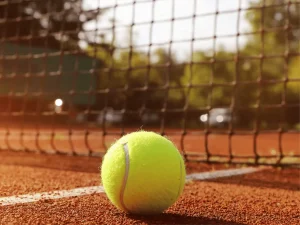
Tennis is a fantastic sport that offers numerous benefits, from physical fitness to mental sharpness. It’s a game that can be enjoyed by people of all ages and skill levels.
Whether you’re looking to pick up a new hobby, stay active, or meet new people, tennis is a great choice.
In this beginner’s guide, we’ve covered the basics of how to play tennis, including the rules, techniques, and strategies. We’ve also provided tips for practicing alone, safety considerations, and resources for further learning.
Remember, the key to improving in tennis is consistent practice and a willingness to learn.
So why not give tennis a try? It’s a fun and challenging sport that’s sure to help bust your boredom. Grab a racquet, hit the court, and start playing!

Hey Everyone!
Chritt here. I just want to say THANK YOU SO MUCH for visiting Boredom Busted. It’s been my passion project going on 7 years now.
I need a favor though. If you have found the page you landed on or explored useful in any ways – please please please share, or comment.
The more engagement on this page – the more I can continue to write and provide helpful content to my visitors like you.
I love you all and thank you again for visiting! Don’t be a stranger and hope to see you back, soon!

